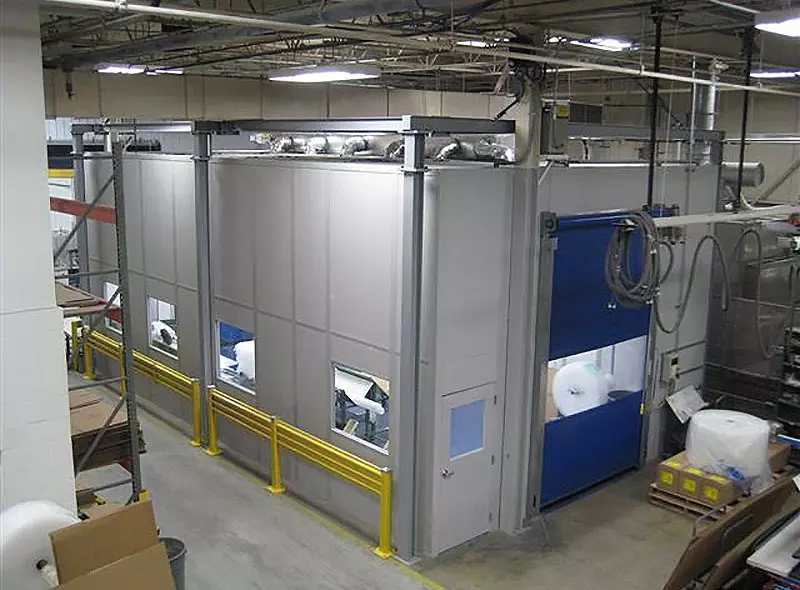


Coordinate measuring machines (CMMs) are an integral component of many manufacturing and production facilities. As precision instruments, CMMs work to ensure the quality control of parts manufactured in the plant. Unfortunately, the manufacturing and production environment is not always the safest or most controlled. This can make it difficult to protect the expensive machinery from the elements present in the production facility, not to mention that fluctuating conditions can negatively impact the machine’s ability to measure consistently.
For this reason, many facilities choose to house their CMMs in dedicated, controlled CMM rooms. These rooms function to ensure that the coordinate measuring machine is kept clean and at a consistent temperature and controlled humidity level. By carefully controlling the CMM’s environment, you can ensure accurate readings, while prolonging the life of your coordinate measuring machine.
To help you develop a CMM room that supports production and efficiency, here’s what you need to know about the most important CMM room standards:
Your CMM’s room size standards will vary depending on the machine you have chosen and the parts you are measuring. In general, you should develop a CMM room that is large enough for the machine, the operator, and any parts that must be measured. It’s also important to consider leaving room for any special environmental control systems needed to protect the CMM.
Because CMMs are so large and bulky, and because many production applications require measurement of larger parts, most CMM rooms do not fit within standard room sizes. Some CMMs can be taller than 16 feet, which means they require tall wall construction and additional accessibility considerations as well. To develop a CMM room that fits your machine, make sure you consider:
From there, it’s often easiest to consult with a CMM room construction expert who can develop a design and plan for the space that can provide the best possible environment for your investment.
Beyond the size of the CMM room, it’s also important to consider CMM room temperature and humidity standards. Coordinate measuring machines are sensitive instruments. Even small fluctuations in temperature and humidity can drastically affect their measurements.
What’s more, the longer your CMM functions in sub-optimal conditions, the shorter its lifespan. This presents a number of concerns, not least of which is the cost of repairing or replacing the technical machine.
In general, it’s best to ensure your CMM room meets the following temperature and humidity standards:
These standards help to minimize the wear and tear on the machine and ensure that your CMM is offering the most accurate measurements possible. These standards address the typical CMM room conditions; consult with your CMM manufacturer for your own unique requirements.
There are a number of CMM room standards that exist beyond just temperature and humidity. Again, a CMM is a big investment — your facility wants to ensure that investment is protected and performing properly. To do so, here are a few additional CMM room standards to understand:
If you’re planning a CMM room, modular construction is one of the best ways to ensure you get the right-sized room that meets all of the standards listed above. Here are a few key ways modular construction can support CMM rooms in ways that traditional construction cannot:
Modular construction makes it easy and cost-effective to build a non-standard-sized CMM room. Your modular construction expert will work with you to understand your CMM room needs, take the necessary measurements, and bring that information back to the production facility. There, each component of your CMM room is built to those exact specifications. With custom capabilities, non-standard sizes aren’t a problem for modular construction.
CMMs are sensitive to any dirt, debris, or loud noise. But, because they are so large, it’s often necessary to install the CMM, then build a CMM room around it. The traditional building process can cause problems here, as the machine is directly exposed to dirt, dust, vibrations from construction work, and loud noises.
Modular components, on the other hand, arrive on-site ready to install, with no need for framing, cutting, or painting. Build your CMM room around your machine without affecting its calibration. Modular construction eliminates the damaging dust, noise, and mess associated with traditional construction.
Another key benefit of modular construction for your CMM room is its long-term versatility. As mentioned earlier, many CMMs are built into their rooms. With traditional construction, this can become problematic should your CMM ever need maintenance or recalibration. With modular construction, it’s easy to simply remove a few panels to allow the service technician the space they need to make repairs, and then replace it when they’re done. This saves both time and money, as you get your CMM up and running more quickly, and with less investment from the technician.
Modular construction offers a wealth of benefits for any CMM room construction project. With fast, clean installation, custom sizes, versatility, and the capabilities to meet any CMM room standard your facility might be facing, modular construction can get you the controlled environment you need, when you need it.
CMM room standards are strict, but they’re easily met with sophisticated modular solutions from Starrco. Tell us the standards you’re working to meet, and we’ll design the modular CMM Room you need. For more information, give us a call at 800-325-4259 or contact us online to request a free quote.